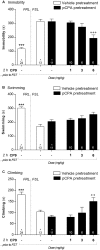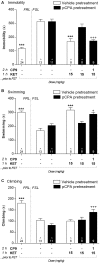S-Ketamine Mediates Its Acute and Sustained Antidepressant-Like Activity through a 5-HT1B Receptor Dependent Mechanism in a Genetic Rat Model of Depression
- PMID: 29379439
- PMCID: PMC5775507
- DOI: 10.3389/fphar.2017.00978
S-Ketamine Mediates Its Acute and Sustained Antidepressant-Like Activity through a 5-HT1B Receptor Dependent Mechanism in a Genetic Rat Model of Depression
Abstract
Rationale: The mechanisms responsible for the unique antidepressant properties of ketamine have only been partly resolved. Recent preclinical reports implicate the neurotransmitter serotonin [5-hydroxytryptamine (5-HT)] in the antidepressant-like response of ketamine, and modulation of 5-HT1B receptors has been hypothesized to attain an important role. Objectives: To evaluate the role of endogenous stimulation of 5-HT1B heteroreceptors in the antidepressant-like activity of S-ketamine. Method: Flinders sensitive line (FSL) rats, a genetic model of depression, were depleted of endogenous 5-HT by 4-chloro-DL-phenylalanine methyl ester HCl administration (pCPA; 86 mg/kg/day for 3 days). In pCPA-pretreated and control FSL rats, the acute and sustained effects of a single dose of S-ketamine (15 mg/kg) and the selective 5-HT1B receptor agonist CP94253 (1-6 mg/kg) alone and in combination with S-ketamine were studied in the forced swim test (FST), a commonly used assay that detects antidepressant activity. Results: pCPA pretreatment decreased cortical 5-HT levels to ∼6% but did not affect the baseline behavioral phenotype of FSL rats. S-ketamine demonstrated acute and sustained antidepressant-like activity, both of which were abolished by 5-HT depletion. Combining S-ketamine with a sub-effective dose of CP94253 (1 mg/kg) rescued S-ketamine's acute and sustained antidepressant-like effects, when CP94253 was administered 2 h prior to the FST. Co-administration of S-ketamine and CP94253 did not affect the plasma level of either compound, suggesting that the observed behavioral interaction could not be ascribed to a kinetic drug-drug interaction. Conclusion: 5-HT1B receptor activation during testing appears to be critical for S-ketamine's antidepressant-like potentials in this model.
Keywords: 5-HT); 5-HT1B receptors; CP94253; antidepressants; forced swim test; ketamine; serotonin (5-hydroxytryptamine.
Figures





Similar articles
-
Differential interaction with the serotonin system by S-ketamine, vortioxetine, and fluoxetine in a genetic rat model of depression.Psychopharmacology (Berl). 2016 Jul;233(14):2813-25. doi: 10.1007/s00213-016-4327-5. Epub 2016 May 28. Psychopharmacology (Berl). 2016. PMID: 27236785
-
Potential involvement of serotonergic signaling in ketamine's antidepressant actions: A critical review.Prog Neuropsychopharmacol Biol Psychiatry. 2016 Nov 3;71:27-38. doi: 10.1016/j.pnpbp.2016.05.007. Epub 2016 Jun 2. Prog Neuropsychopharmacol Biol Psychiatry. 2016. PMID: 27262695 Review.
-
Ketamine treatment involves medial prefrontal cortex serotonin to induce a rapid antidepressant-like activity in BALB/cJ mice.Neuropharmacology. 2017 Jan;112(Pt A):198-209. doi: 10.1016/j.neuropharm.2016.05.010. Epub 2016 May 17. Neuropharmacology. 2017. PMID: 27211253
-
Ketamine elicits sustained antidepressant-like activity via a serotonin-dependent mechanism.Psychopharmacology (Berl). 2013 Jul;228(1):157-66. doi: 10.1007/s00213-013-3024-x. Epub 2013 Mar 2. Psychopharmacology (Berl). 2013. PMID: 23455595
-
Mechanisms of ketamine action as an antidepressant.Mol Psychiatry. 2018 Apr;23(4):801-811. doi: 10.1038/mp.2017.255. Epub 2018 Mar 13. Mol Psychiatry. 2018. PMID: 29532791 Free PMC article. Review.
Cited by
-
The Selective Serotonin 5‑HT2A Receptor Agonist (S)‑3-(2,5-Dimethoxy-4-(trifluoromethyl)phenyl)piperidine (LPH-5) Induces Persistent and Robust Antidepressant-Like Effects in Rodents.ACS Pharmacol Transl Sci. 2025 May 29;8(6):1791-1803. doi: 10.1021/acsptsci.5c00208. eCollection 2025 Jun 13. ACS Pharmacol Transl Sci. 2025. PMID: 40534669
-
NOP agonists prevent the antidepressant-like effects of nortriptyline and fluoxetine but not R-ketamine.Psychopharmacology (Berl). 2018 Nov;235(11):3093-3102. doi: 10.1007/s00213-018-5004-7. Epub 2018 Aug 25. Psychopharmacology (Berl). 2018. PMID: 30145654
-
Neuroimaging-Derived Biomarkers of the Antidepressant Effects of Ketamine.Biol Psychiatry Cogn Neurosci Neuroimaging. 2023 Apr;8(4):361-386. doi: 10.1016/j.bpsc.2022.11.005. Epub 2022 Nov 26. Biol Psychiatry Cogn Neurosci Neuroimaging. 2023. PMID: 36775711 Free PMC article. Review.
-
Role of Serotonergic System in the Antidepressant Actions of mGlu2/3 Receptor Antagonists: Similarity to Ketamine.Int J Mol Sci. 2019 Mar 13;20(6):1270. doi: 10.3390/ijms20061270. Int J Mol Sci. 2019. PMID: 30871246 Free PMC article. Review.
-
The role of serotonin neurotransmission in rapid antidepressant actions.Psychopharmacology (Berl). 2022 Jun;239(6):1823-1838. doi: 10.1007/s00213-022-06098-5. Epub 2022 Mar 25. Psychopharmacology (Berl). 2022. PMID: 35333951 Review.
References
LinkOut - more resources
Full Text Sources
Other Literature Sources
Miscellaneous

